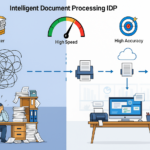In the ever-evolving landscape of digital document handling, the distinctions between Document Transfer Platforms and Document Management Systems (DMS) play a crucial role, particularly in industries spanning shipping, manufacturing, supply chain, trade, finance, energy, services, and government entities. Let’s dissect the functionalities, differences, and advantages inherent in these two systems to shed light on their unique roles, navigating the intricate terrain of document management in the digital age.
Document Management System (DMS):
A Document Management System serves as a comprehensive solution for receiving, tracking, managing, and storing electronic documents across various channels. Traditionally associated with reducing paper loads, DMS often integrates with enterprise content management systems, incorporating functionalities like document imaging, workflows, and record management.
Key Characteristics:
- Internal Workflow: Primarily designed for internal document workflows within an organization.
- Digitization: Often linked with scanning/photocopy machines to digitize paper documents.
- Features: Offers features like document imaging, workflows, and record management.
- Limitation: Lacks the feature of immutability, compromising the highest degree of document security, especially for electronic documents of title.
Document Transfer Platform:
Contrasting with DMS, a Document Transfer Platform, exemplified by solutions like the CargoX Platform for Blockchain Document Transfer (BDT), introduces innovative features not commonly found in traditional systems. At its core, it prioritizes the immutability of document activities and robust, tamper-proof possession transfer, resembling a digital courier service.
Key Characteristics:
- Immutability: Utilizes blockchain technology for an unhackable record, ensuring the highest document security.
- Possession Transfer: Facilitates robust, tamper-proof document possession transfer, akin to a courier service.
- Global Transfer: Designed for document transfer between users of different organizations globally.
- Cryptographic Proof: Provides cryptographic proof of document title, enhancing security and authenticity.
Trust as the Key Differentiator:
The pivotal difference lies in the level of trust these systems provide to users. Document Transfer Platforms come to the forefront when the transfer of documents of title demands speed, reliability, and cryptographic assurance against unauthorized access. Conversely, Document Management Systems find their niche in internal use, focusing on managing document copies for editing, version control, and presentation, where ownership is not the central concern.
SDEX: Pioneering Trust in Document Transfer
As we delve into the intricate world of digital document ecosystems, SDEX stands as a trailblazer, utilizing innovative technologies to redefine document transfer dynamics. The integration of blockchain epitomizes SDEX’s commitment to trust, security, and efficiency, transcending the conventional understanding of document transactions. Document transfer, for SDEX, transcends mere file movement; it’s about instilling unwavering confidence in every transaction, ensuring the integrity, and unequivocal ownership of vital documents.
Conclusion:
As industries pivot towards digital transformation, the choice between a Document Transfer Platform and a Document Management System hinges on the nature of document handling needs. SDEX, as a trailblazer in this space, recognizes the nuances and unique requirements of businesses operating in the digital realm. Through our cutting-edge solutions, we aim to empower organizations with the tools they need to navigate the intricate landscape of document management, ensuring security, efficiency, and trust in every transaction.






